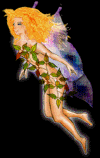By Silver RavenWolf


The majority of fairy folk find their roots in European folklore, although legends and lore of similar entities circulate through most of human history, regardless of religious belief, cultural nuances, or socio-economic status. From Eskimos to the Japanese, the tales, antics, and dangers of the "little folk" persist. The belief in fairies appears linked to the same area of human consciousness that creates a connection between religious mythos and metaphysical practices.
Through the tumultuous history of humankind, the origin of fairies has been hotly debated. Are they spirits of the dead? Fallen angels? The essance of plant and tree energy? Do they resemble humasns only because we want them to, or can they really manifest in pseudo-human form? Are they lore-remnants of a race of people who have long since merged with the dust of our ever-changing planet, or is our belief in them so strong that we have actually manifested them into the astral through our own process of thought creation? Is that crazy woman walking down the street and muttering to herself as she adjust her red hat just an odd lady? Or is she a Redcap? Sagas and legends evolve from traditional stories, that although containing fictional and imaginative elements, may have a historical basis. These sagas and legends could represent in the popular memory a real happening that was extraordinary enought to be remembered and embellished. Perhaps our fairies fit the profile of the saga or legend?
Fairy legend doesn't just revolve around cute little people with gossamer wings, or the helpful brownie. A compendium of fairy lore paints them, if not as downright malicious, with at least little regard for human morality. At best, quite a few legends portray the fairy population with prankster mentality. The most powerful and unpredictable personalities manifest as the Sidhe. Originally, the word sidhe meant mound or hill, or the dwelling place of the DeDanaan after their defeat by the Milesians. These ancient shining ones, thus exiled underground, became part of fold legend, metamorphosing into the fairies as Sidhe, the people of the hills. The traditional characteristics of fairies can be found in European literature as in Shakespeares's A Midsummer Night's Dream and Romeo and Juliet (in Mercutio's "Queen Mab" speech), and other great works. To escape the magics of the most dangerous of fairies, one would employ the use of iron, as this metal destroys all fairy magic. Te majority of fairies appear to live in some sort of organized society, two factors appear to remain constant: the absence of sickness, and the absence of time.
If one wishes to contact the fairies, or recieve their blessings, a customary offering of milk and honey should be left by the back door of your home on the first day of spring. Then, as the days warm and the world around you comes alive with the energy of manifestation, you should take walks around your home or spend time meditating outdoors, sending loving energy to the area. As your thoughts merge witht the universal consciousness, you will be sending the signal that you come in peace, merging the spirit of yourself with the energy patters of the land.
Copyright © 1997 by Llewellyn Worldwide.


